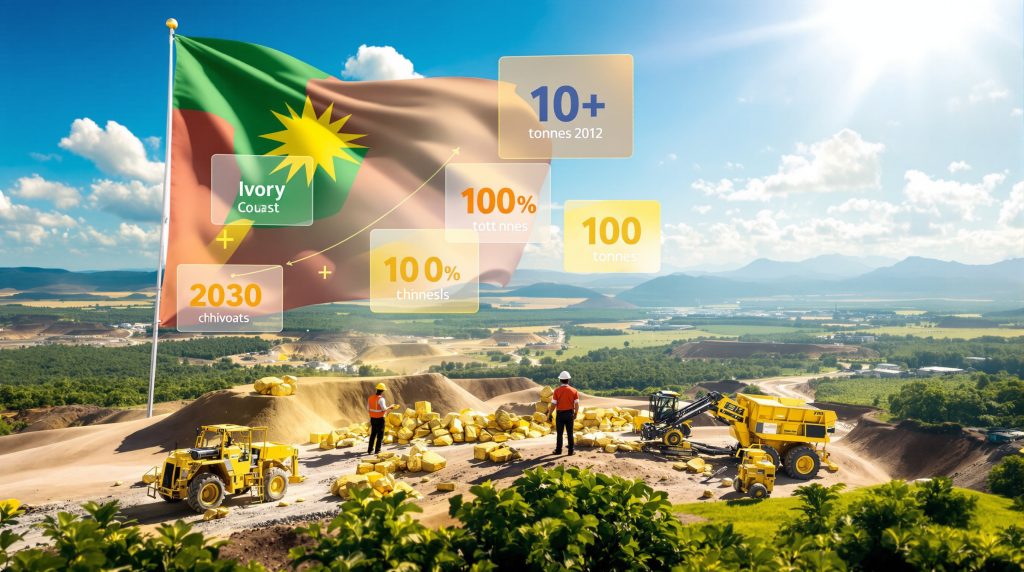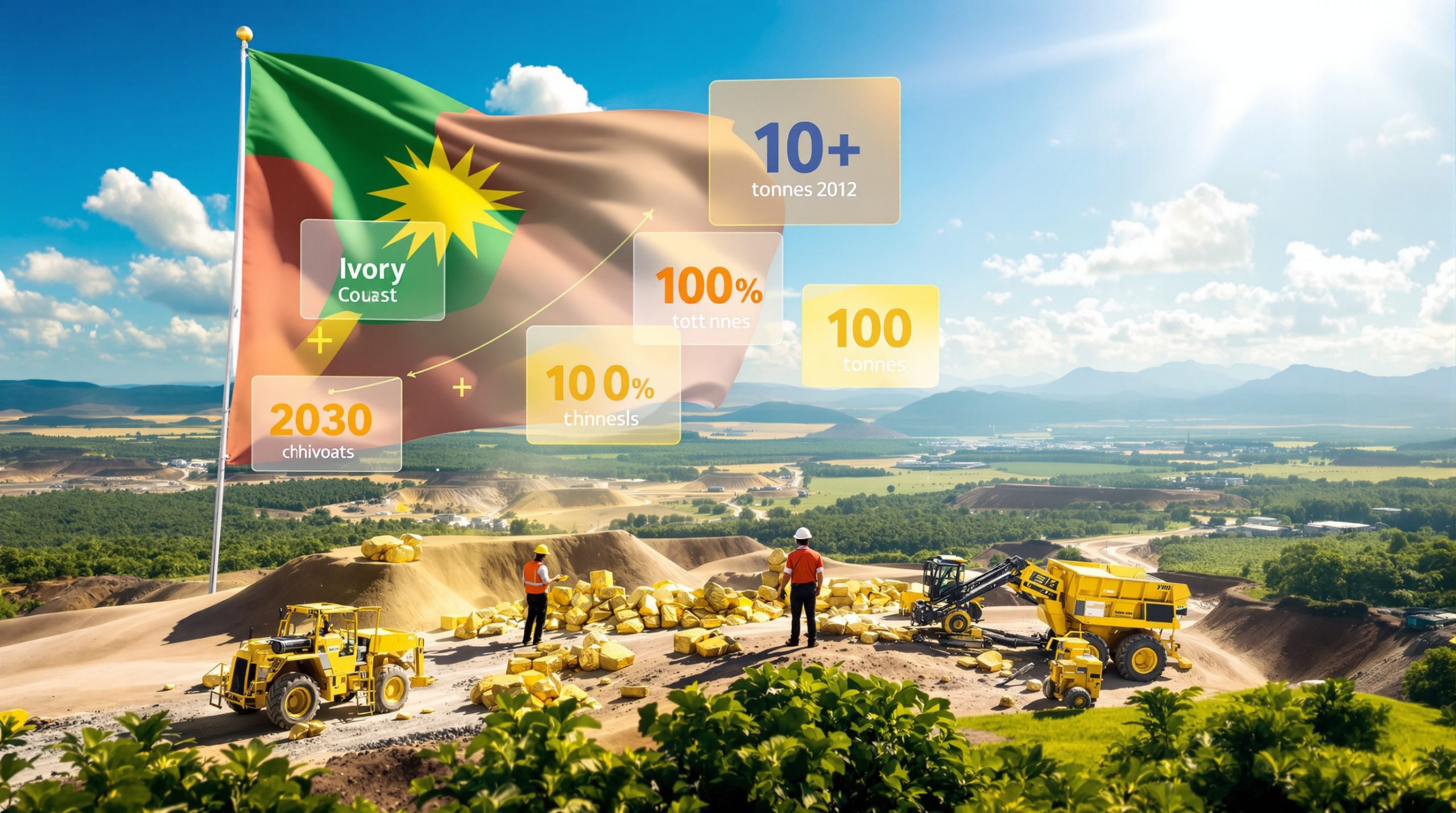Understanding Ivory Coast's Mining Sector Growth Strategy
Ivory Coast has been strategically shifting its economic foundation from agricultural dependence toward resource development, with the mining sector emerging as a crucial pillar of growth. Over the past decade, the contribution of mining to the country's GDP has increased substantially from 1.5% to 4%, signaling successful diversification efforts in West Africa's largest economy.
The government has implemented a comprehensive vision for resource sector expansion, aiming to position Ivory Coast as a regional mining powerhouse by 2030. This transformation is particularly evident in gold production, which has experienced remarkable growth from merely 10 tonnes in 2012 to an impressive 58 tonnes in 2024. Official projections suggest this upward trajectory will continue, with production expected to reach 62 tonnes by 2025 and an ambitious target of 100 tonnes annually by 2030.
The Strategic Importance of Mining Diversification
While Ivory Coast has long been recognized as the world's leading cocoa producer, this agricultural dominance created economic vulnerabilities due to price volatility and climate change impacts. The strategic pivot toward mining represents a deliberate effort to create multiple economic engines that can provide greater stability and sustainable growth opportunities.
The mining sector expansion has already generated significant employment opportunities in regions previously dependent solely on agricultural activities. Infrastructure development has accelerated in mining areas, improving transportation networks, power supply, and community facilities that benefit broader economic activities beyond the mining operations themselves.
According to government spokesperson Amadou Coulibaly, the recent expansion of mining permit processes reflects "a strategy to unlock untapped mineral potential and diversify the economy beyond cocoa." This approach has already begun yielding results, with new mines contributing significantly to export revenues and foreign investment inflows.
Current Mining Landscape in Ivory Coast
The Lafigué gold mine, operated by Endeavour Mining, exemplifies the success of Ivory Coast's mining development strategy. As one of the newest operations, it has become a key driver of increased national gold production. The mine employs advanced extraction technologies and maintains high environmental standards, setting benchmarks for the sector.
Beyond gold, exploration activities have identified promising deposits of strategic minerals essential for the global energy transition, including nickel, cobalt, and manganese. These resources position Ivory Coast advantageously in the rapidly expanding market for battery metals and renewable energy components.
The mining landscape has evolved from primarily artisanal operations a decade ago to sophisticated industrial mining complexes employing thousands of workers and utilizing advanced technologies. This progression has required substantial investments in technical training and capacity building to develop a skilled local workforce capable of supporting modern mining industry evolution.
What New Mining Permits Has Ivory Coast Recently Granted?
Ivory Coast has recently expanded its mining exploration potential by granting 11 new exploration permits to both local and international companies. These permits, approved during a cabinet meeting in late 2025, represent a significant step in the country's resource development strategy and reflect growing investor confidence in Ivory Coast's mining potential.
The permits are valid for four years, providing companies with sufficient time to conduct thorough geological assessments and feasibility studies. This timeframe aligns with international exploration standards while ensuring that permit holders make meaningful progress toward resource development.
Gold Exploration Permits: Expanding the Golden Frontier
Of the 11 permits issued, eight are specifically allocated for gold exploration, highlighting the continued prominence of this precious metal in Ivory Coast's mining strategy. These permits have been distributed across different regions of the country, creating a geographically diverse exploration portfolio.
Resolute Exploration Côte d'Ivoire secured permits for developing the promising Doropo gold region in northern Ivory Coast. This area has shown significant potential based on preliminary geological surveys, with mineralization patterns similar to other productive gold mines in West Africa. The company's technical team has identified multiple target zones for detailed exploration using advanced geophysical techniques.
Tieto Minéral, which already operates the productive Abujar gold mine west of Abidjan, received additional exploration rights in adjacent areas. This expansion strategy allows the company to leverage existing operational infrastructure while potentially extending the productive life of their mining operations through new discoveries. Geological continuity in these extension zones suggests high probability of additional gold-bearing formations.
Other gold exploration permits have been strategically allocated in areas with promising geological indicators but limited previous exploration. These "greenfield" sites represent opportunities for major new discoveries that could significantly impact national production figures in the coming years.
Strategic Mineral Exploration Permits
Beyond gold, three permits have been granted specifically for exploring critical minerals including chrome, manganese, nickel, cobalt, and copper. This diversification represents an important strategic shift as global demand for battery metals and industrial minerals continues to grow in response to energy transition needs.
The chrome and manganese exploration permits target regions with known mafic and ultramafic geological formations similar to productive deposits in neighboring countries. These minerals have critical applications in steel manufacturing and alloy production, providing potential export opportunities to industrial markets.
The exploration permits for nickel, cobalt, and copper focus on areas with promising geochemical signatures identified through preliminary surveys. These battery metals have seen substantial price increases due to their essential role in electric vehicle production and renewable energy storage systems, potentially positioning Ivory Coast as a supplier to the green technology value chain.
This balanced approach to permit allocation demonstrates the government's commitment to diversifying the mining sector while continuing to develop its established gold production capabilities.
Why is Ivory Coast Becoming a Mining Investment Destination?
Ivory Coast has emerged as a preferred mining investment destination in West Africa, attracting substantial capital and technical expertise from global mining companies. This increasing attractiveness stems from multiple competitive advantages that distinguish the country from its regional peers.
Regional Stability Advantage
In a region experiencing significant political turbulence, Ivory Coast offers remarkable stability that has become a decisive factor for mining investors. While neighboring countries such as Mali, Burkina Faso, and Niger have experienced military takeovers and increasing state intervention in mining assets, Ivory Coast has maintained democratic governance and policy consistency.
This stability contrast is particularly significant as military governments in surrounding countries have implemented aggressive resource nationalism policies, creating unpredictable operating environments for international mining companies. By comparison, Ivory Coast provides investors with greater certainty regarding regulatory frameworks, taxation policies, and repatriation of profits.
Security conditions also favor Ivory Coast, with mining operations facing fewer threats from non-state armed groups compared to operations in the Sahel region. This security advantage translates to lower operational costs, as companies require less extensive security infrastructure and face fewer disruptions to production and transportation activities.
The country's political leadership has consistently signaled its commitment to maintaining an investor-friendly climate, recognizing that capital-intensive mining projects require long-term stability to achieve profitable operations. This political commitment has created a virtuous cycle, where successful early investments have attracted additional companies seeking similar favorable conditions.
Regulatory Framework and Investment Incentives
Ivory Coast has developed a competitive mining code that balances national interests with investor requirements. The four-year validity period for exploration permits provides companies with sufficient time to conduct thorough geological assessments while maintaining reasonable development timelines.
The permit renewal process follows transparent procedures with clear criteria for extensions, reducing regulatory uncertainty for exploration companies. Conversion pathways from exploration permits to mining licenses are well-defined, creating a predictable progression for projects that identify commercially viable deposits.
The government has established support mechanisms for exploration companies, including access to geological data, streamlined customs procedures for specialized equipment, and technical assistance through the national mining administration. These facilitation measures reduce startup costs and accelerate the exploration timeline.
Fiscal incentives structured into the mining regulatory framework include graduated royalty rates that acknowledge the different economics of various minerals, tax holidays during initial production periods, and provisions for accelerated capital recovery. These arrangements enhance project economics while ensuring appropriate returns to the national treasury as operations mature.
The regulatory framework also incorporates stability clauses that protect investments from arbitrary changes in fiscal terms, providing investors with greater confidence in long-term project viability. This regulatory predictability has been a significant factor in attracting major mining companies to prioritize Ivory Coast in their West African portfolios.
Who Are the Major Mining Players in Ivory Coast?
The mining sector in Ivory Coast features a diverse ecosystem of operators ranging from major international corporations to emerging local enterprises. This mix of participants has created a dynamic industry landscape with varying operational approaches and development strategies.
International Mining Companies Operating in Ivory Coast
Endeavour Mining has established a significant presence in Ivory Coast, with its flagship Lafigué operation representing one of the country's most advanced gold mining complexes. The mine incorporates state-of-the-art processing facilities capable of handling complex ores while maintaining high recovery rates. Lafigué's production profile includes an annual capacity exceeding 200,000 ounces of gold, contributing substantially to national output figures.
Canadian miner Barrick has developed multiple projects in Ivory Coast, leveraging its global technical expertise and capital resources to advance exploration properties toward production. The company's long-term strategy in the country includes both near-surface oxide deposits for immediate development and deeper, more complex formations requiring advanced extraction technologies.
Perseus Mining has successfully navigated the full development cycle in Ivory Coast, progressing from early exploration to productive mining operations. Their approach emphasizes community engagement and environmental responsibility, establishing benchmarks for sustainable mining practices in the region.
Roxgold and Fortuna Mining have also established significant operations in the country, each bringing specialized technical capabilities that address specific geological challenges. Their continued investment signals confidence in both the resource potential and the operating environment.
Collectively, these international operators have invested billions in exploration, mine development, and processing infrastructure. Their operational presence has created thousands of direct jobs while generating substantial tax revenues, royalty payments, and export earnings that benefit the broader economy.
Local Mining Enterprises and Joint Ventures
Alongside international operators, Ivory Coast has witnessed the emergence of domestic mining companies that play increasingly important roles in the sector. These local enterprises often begin as service providers to international miners before developing technical and financial capabilities to undertake their own exploration and production activities.
The government has encouraged partnership models between international and local entities through regulatory incentives and local content requirements. These mining joint ventures trends facilitate knowledge transfer and capacity building within the domestic mining sector while providing international companies with valuable local insights and relationships.
Several innovative partnership structures have emerged, including equity-sharing arrangements, graduated ownership transfers, and service contracts with conversion options. These flexible approaches allow participants to align their respective strengths while sharing development risks appropriately.
Capacity building initiatives supported by both government agencies and international mining companies have accelerated the development of domestic technical expertise. Training programs focusing on geological assessment, mining engineering, environmental management, and financial modeling have created a growing pool of skilled professionals contributing to the sector's expansion.
The increasing participation of local financial institutions in mining project funding represents another significant development. Domestic banks have developed specialized mining finance units capable of evaluating resource projects and structuring appropriate financing packages, reducing dependence on international capital markets.
How is Ivory Coast's Mining Sector Transforming the Economy?
The rapid expansion of mining activities has catalyzed broad economic changes throughout Ivory Coast, creating new development pathways and strengthening the country's fiscal foundation. This transformation extends far beyond the direct economic contributions of mineral extraction.
Economic Diversification Beyond Cocoa
Traditionally dominated by cocoa production, Ivory Coast's economy has long been vulnerable to agricultural commodity price fluctuations. The growing mining sector has significantly reduced this vulnerability by creating an alternative source of export earnings with different market cycles.
Mining's contribution to export revenues has increased substantially, helping to stabilize the country's trade balance during periods of agricultural market weakness. The sector generated approximately $2.4 billion in export value in 2024, representing a critical source of foreign exchange that supports broader economic stability.
Employment generation in mining regions has been particularly significant, with each formal mining position typically creating multiple indirect jobs in the supply chain and service sectors. The mining workforce, now exceeding 34,000 direct employees, receives wages substantially above national averages, stimulating local economies through increased consumer spending.
Infrastructure development linked to mining operations has delivered broad economic benefits extending beyond the sector itself. Road improvements, power distribution extensions, and water management systems developed for mining projects have enhanced connectivity and service access for previously isolated communities, enabling additional economic activities.
The mining sector has also stimulated the development of specialized service industries ranging from analytical laboratories to equipment maintenance facilities. These business ecosystems create additional employment opportunities while building national technical capabilities that benefit other industrial sectors.
Investment Attraction and Future Growth
The mining sector has demonstrated remarkable success in attracting investment capital, with total commitments reaching approximately $7 billion over the past five years. This influx represents a significant portion of Ivory Coast's total foreign direct investment during this period.
Projected investment growth linked to the new exploration permits is expected to generate an additional $1.2 billion in capital deployment over the next four years. These funds will support not only geological assessment activities but also feasibility studies, environmental baseline monitoring, and community engagement programs that lay groundwork for potential mine development.
Long-term economic impact forecasts suggest that if current exploration programs achieve typical success rates, mining's contribution to GDP could reach 7-8% by 2030. This growth would substantially alter the structure of the national economy while generating significantly increased tax revenues to support public services and infrastructure development.
The secondary economic impacts are equally significant, with mining companies establishing foundation programs that support education, healthcare, and small business development in their operational areas. These social investments complement government services and create sustainable development opportunities that will extend beyond the operational life of individual mines.
As the sector matures, domestic value addition opportunities are emerging through beneficiation facilities that process raw minerals into higher-value products. Preliminary studies for a gold refinery and jewelry manufacturing hub demonstrate the potential for capturing additional economic value from mineral resources.
What Challenges and Opportunities Exist in Ivory Coast's Mining Sector?
Despite its impressive growth trajectory, Ivory Coast's mining sector faces several significant challenges that require strategic solutions. These challenges exist alongside substantial opportunities that could further accelerate sector development and economic benefits.
Infrastructure and Operational Challenges
Power supply requirements for mining operations represent a critical constraint, with many projects requiring dedicated generation capacity to ensure reliable operations. The national electricity grid, while expanding, still lacks sufficient coverage and reliability in some remote areas with high mineral potential.
Transportation infrastructure for mineral exports remains underdeveloped in certain regions, increasing logistics costs and limiting the economic viability of some deposits. Port capacity constraints at peak shipping periods can create bottlenecks that impact production schedules and delivery commitments.
Technical expertise availability presents another challenge, particularly for specialized roles in metallurgical processing, mine planning, and environmental management. While educational institutions have expanded relevant programs, the rapid growth of the sector has created significant demand for experienced professionals that exceeds current domestic supply.
Equipment availability and maintenance services represent operational challenges, especially for operations in more remote areas. Supply chain disruptions can significantly impact production continuity, necessitating larger inventory holdings and redundant systems that increase capital requirements.
These infrastructure and operational challenges create opportunities for strategic investors in complementary sectors. Companies developing independent power projects, specialized logistics services, technical training programs, and equipment maintenance facilities can find substantial business opportunities supporting the expanding mining ecosystem.
Environmental and Social Considerations
Environmental protection requirements for permit holders have become increasingly stringent, reflecting both regulatory evolution and community expectations. Mining companies must now implement comprehensive management systems addressing water quality, air emissions, biodiversity protection, and land rehabilitation to secure and maintain their social license to operate.
Community engagement frameworks have developed significantly, with successful projects establishing multi-stakeholder dialogue mechanisms that identify priorities for local development initiatives. These engagement processes have evolved from simple consultation to active participation models where communities influence operational decisions that affect their interests.
Sustainable mining practices and standards have become competitive differentiators, with leading companies implementing international best practices that exceed minimum regulatory requirements. These enhanced approaches include water recycling systems, renewable energy integration, biodiversity offset programs, and progressive rehabilitation techniques that minimize long-term environmental impacts.
The implementation of these advanced environmental and social practices creates opportunities for specialized service providers in environmental monitoring, community development, renewable energy integration, and sustainability certification. Companies that develop expertise in these areas can support multiple mining operations while transferring knowledge between projects.
Market Opportunities and Global Demand
Gold prices analysis remain favorable for Ivory Coast's dominant mineral product, with prices maintaining strong levels despite global economic uncertainties. Analysts project continued strength in gold markets driven by central bank purchasing, investment demand, and limited supply growth from major global producers.
Critical minerals demand for energy transition applications presents substantial opportunities for diversification beyond gold. Minerals such as nickel, cobalt, and manganese—all present in Ivory Coast's geological formations—face significant demand growth driven by electric vehicle production and renewable energy storage requirements.
Ivory Coast's competitive position in global mining markets benefits from relatively low operating costs compared to many established mining jurisdictions. Production costs for gold operations typically range from $800-950 per ounce, providing substantial margins at current market prices and creating resilience against potential price volatility.
Market access advantages through established trade relationships with European and Asian consumers provide additional competitive benefits. The country's well-developed port facilities and regular shipping connections to major markets reduce transportation costs and delivery timeframes compared to more landlocked competitors.
These market opportunities attract both specialized junior exploration companies focused on specific mineral targets and diversified mining corporations seeking to establish balanced portfolios across multiple commodities. This diversity of market participants creates a dynamic exploration environment with multiple approaches to resource development.
What Does the Future Hold for Ivory Coast's Mining Industry?
The future trajectory of Ivory Coast's mining industry appears strongly positive based on current development trends, exploration results, and market conditions. The sector is positioned for continued expansion while addressing key challenges that could constrain growth.
Exploration to Production Timeline
The typical development cycle from initial permit to operational mine in Ivory Coast ranges from 5-8 years, depending on geological complexity, infrastructure requirements, and permitting processes. This timeline includes approximately 2-3 years of progressive exploration activities, 1-2 years for feasibility studies and environmental assessments, and 2-3 years for construction and commissioning.
Success rates for exploration projects in the country have exceeded global averages, with approximately 18-22% of advanced exploration programs identifying economically viable resources. This relatively high conversion rate reflects both the quality of the geological environment and the improving precision of initial target selection using advanced geophysical techniques.
Capital requirements for mine development vary substantially based on production scale, processing complexity, and infrastructure needs. Typical medium-scale gold operations require $150-250 million in development capital, while larger projects or those with more complex metallurgy may require $300-500 million or more.
The financial ecosystem supporting mining development has matured significantly, with project financing now available from multiple sources including international mining funds, development finance institutions, equipment suppliers, and increasingly from regional banks with mining sector expertise. This diverse funding landscape has reduced capital constraints that previously limited development pace.
Production Growth Projections
Five-year forecasts for mineral production volumes indicate continued strong growth, with gold output projected to increase from the current 58 tonnes annually to approximately 75-80 tonnes by 2030. This growth will derive from both expansion of existing operations and the development of new mines from the current exploration pipeline.
Revenue projections based on these production volumes suggest the sector could generate $4.5-5 billion annually in export value by 2030, assuming moderate price projections. This would represent a near doubling of the sector's current economic impact and a significant contribution to national export earnings.
Employment and skills development forecasts suggest the direct mining workforce could expand to approximately 50,000 positions by 2030, with an additional 150,000-200,000 indirect jobs in the supply chain and service sectors. This job creation will be accompanied by continued workforce development programs to increase local participation in technical and management roles.
The geographic distribution of mining activities is expected to expand, with new operations developing in currently underexplored regions of the country. This expansion will extend economic benefits to additional communities while creating development corridors that can support other economic activities.
Strategic Development Goals
Government targets for mining sector contribution to GDP aim to reach 8% by 2030, representing a doubling of the current contribution level. This ambitious target requires both production growth and increased domestic value addition through processing activities.
Localization and value addition strategies focus on developing downstream processing capabilities that capture additional economic value from mineral resources. Preliminary feasibility studies have identified opportunities for gold refining, jewelry manufacturing, and industrial mineral processing that could significantly increase the economic impact of the sector.
Regional mining hub aspirations position Ivory Coast as a service center and knowledge base for the broader West African mining industry. The development of specialized technical services, equipment maintenance facilities, and training institutions could extend the country's mining influence beyond its borders while creating additional economic opportunities.
Research and technology innovation investments aim to address specific challenges in the mining value chain, including improved recovery methods for complex ores, reduced water and energy consumption, and more effective site rehabilitation techniques. These innovations could create additional competitive advantages while reducing environmental impacts.
The integration of mineral exploration insights with broader economic diversification strategies represents perhaps the most significant strategic goal. By leveraging mining-related infrastructure, workforce skills, and business capabilities to support other industrial sectors, Ivory Coast aims to create sustainable economic growth that extends beyond the operational life of individual mines.
Addressing Challenges for Sustainable Mining Growth in Ivory Coast
For Ivory Coast to fully realize its mining potential while ensuring sustainable development, several key challenges must be systematically addressed through coordinated efforts by government, industry, and communities.
Balancing Foreign Investment with Local Participation
Creating meaningful opportunities for domestic businesses and professionals remains essential for maximizing economic benefits from the mining sector. Current regulations require progressive increases in local content, but implementation challenges persist, particularly for specialized technical services and equipment.
Successful approaches include structured supplier development programs where international mining companies provide technical assistance and advance contracts to local businesses. These programs have enabled domestic companies to build capacity gradually while meeting quality and reliability requirements.
Financial mechanisms supporting local participation have evolved, with dedicated funding facilities providing capital access for domestic mining service providers. These arrangements often include technical assistance components that help local businesses achieve operational standards required by international mining companies.
Joint venture structures between international and local companies have proven effective when they include genuine skills transfer components and clear progression pathways for local partners. The most successful partnerships establish specific milestones for increasing local management and ownership percentages as capabilities develop.
Enhancing Infrastructure for Mining Expansion
Coordinated infrastructure development represents perhaps the most significant enabler for continued mining growth. The government has implemented planning processes that align public infrastructure investments with mining development corridors, maximizing economic benefits while sharing costs appropriately.
Power supply expansion has received particular attention, with several independent power projects under development specifically targeting mining regions. These include both conventional generation and increasingly renewable energy installations that reduce operating costs while improving environmental performance.
Transportation infrastructure coordination has improved through multi-user planning approaches that optimize road and rail development to serve multiple mining operations. These shared-use models reduce individual project capital requirements while creating more sustainable infrastructure management arrangements.
Water management infrastructure has gained importance as operations expand in regions with seasonal water availability challenges. Regional water management schemes that balance mining, agricultural, and community needs have proven more effective than isolated solutions developed by individual mining operations.
Strengthening Environmental and Social Governance
Environmental standards harmonization has progressed significantly, with regulations increasingly aligned with international best practices. This alignment provides clarity for investors while ensuring appropriate environmental protection measures.
Community development agreements have evolved from discretionary corporate social responsibility initiatives to structured frameworks with clear commitments, implementation timelines, and monitoring mechanisms. These agreements typically address education, healthcare, economic diversification, and infrastructure priorities identified through participatory planning processes.
Artisanal mining integration represents a persistent challenge, with informal operators active in many areas with mining potential. Progressive formalization programs have shown promising results by providing technical assistance, access to finance, and marketing support for small-scale miners who operate within regulatory frameworks.
Transparency initiatives including implementation of the Extractive Industries Transparency Initiative (EITI) standards have strengthened governance and public confidence in the sector. Regular public reporting of mining revenues, royalty payments, and license allocations has reduced perceptions of corruption while improving accountability.
These integrated approaches to addressing key challenges demonstrate Ivory Coast's commitment to developing a mining sector that delivers sustainable benefits while meeting international environmental and social standards. The country's progress in these areas has further strengthened its position as a preferred mining investment destination in West Africa.
Are You Ready to Identify Tomorrow's Mineral Discovery Winners?
Stay ahead of the market with Discovery Alert's proprietary Discovery IQ model that instantly notifies you of significant ASX mineral discoveries, helping you capitalise on opportunities before the broader market. Explore why major discoveries can lead to exceptional returns by visiting Discovery Alert's dedicated discoveries page and begin your 30-day free trial today.




